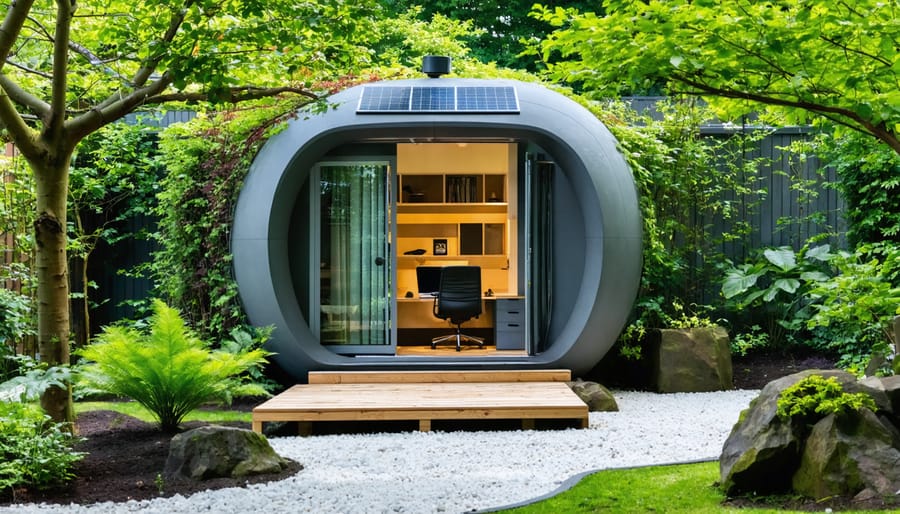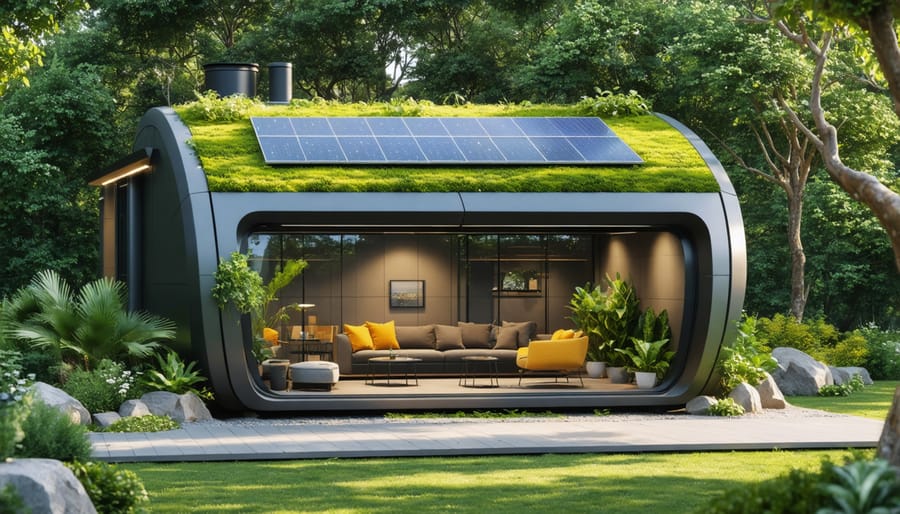Transform Your Outdoor Office Into an Eco-Friendly Paradise

Transform your office into a beacon of sustainability by implementing proven eco-friendly practices that reduce environmental impact while cutting operational costs. Modern workplaces are increasingly recognizing that sustainable operations aren’t just good for the planet—they’re essential for business success and employee well-being. From energy-efficient lighting systems to paperless workflows, sustainable office practices have evolved from simple recycling programs into comprehensive strategies that touch every aspect of daily operations.
Today’s forward-thinking businesses are discovering that sustainable practices lead to significant advantages: reduced utility bills, improved employee satisfaction, enhanced brand reputation, and a smaller carbon footprint. Whether you’re managing a small startup or a large corporate office, implementing sustainable practices isn’t just an environmental choice—it’s a smart business decision that positions your organization for long-term success in an increasingly eco-conscious world.
This guide explores practical, cost-effective solutions to create a more sustainable office environment, focusing on immediate actions that deliver measurable results.
Smart Design for Natural Climate Control
Strategic Shade Solutions
Creating a comfortable and sustainable outdoor workspace starts with smart shading strategies that work in harmony with nature. Natural shade solutions not only reduce energy consumption but also enhance the aesthetic appeal of your workspace. Pergolas offer an excellent foundation for climate control solutions, especially when combined with climbing plants that provide additional cooling through evapotranspiration.
Retractable awnings present a flexible option, allowing you to adjust shade coverage based on the sun’s position throughout the day. These can be manually operated or equipped with solar-powered motors for enhanced convenience and energy efficiency. Consider installing weather-resistant fabric awnings made from recycled materials to minimize environmental impact.
Strategic placement of native vegetation around your workspace serves multiple purposes. Trees and large shrubs not only provide natural shade but also improve air quality, reduce noise pollution, and create a more pleasant working environment. For immediate shade solutions, container gardens with fast-growing vines can be positioned to shield specific areas while adding a touch of green to your workspace. Remember to choose drought-resistant plants that require minimal maintenance and water consumption.
Proper Ventilation Planning
Natural airflow is a game-changer for outdoor office comfort and energy efficiency. Start by positioning your structure to take advantage of prevailing winds and cross-ventilation opportunities. Install windows on opposite walls to create a natural flow path, and consider adding clerestory windows near the roof to help hot air escape upward.
Adjustable vents at both low and high points of your office can help regulate airflow throughout the day. During warmer months, these vents can be opened to create a cooling chimney effect, while in cooler weather, they can be partially closed to maintain comfortable temperatures.
Strategic landscaping can enhance natural ventilation too. Plant deciduous trees on the south and west sides to provide shade in summer while allowing winter sun through. Consider installing window awnings that can be adjusted based on the season and time of day.
For those days when natural ventilation isn’t enough, ceiling fans can help circulate air without consuming much energy. Remember to clean vents and fans regularly to maintain optimal airflow and prevent dust buildup.

Sustainable Materials and Construction
Recycled and Renewable Materials
When choosing materials for your outdoor office space, opt for sustainable options that minimize environmental impact while maintaining durability. Bamboo is an excellent renewable choice for decking and wall panels, as it grows quickly and requires minimal processing. Reclaimed wood from old buildings or furniture adds character while giving materials a second life.
For insulation, consider recycled denim or cellulose made from post-consumer paper products. These materials provide excellent temperature regulation while keeping waste out of landfills. Recycled plastic lumber is perfect for outdoor furniture and structural elements, offering weather resistance without contributing to new plastic production.
Cork flooring presents another sustainable option, harvested from cork oak trees without harming them. For roofing, recycled metal panels reflect heat effectively and can last decades. Many manufacturers now offer composite materials made from a mix of recycled wood fibers and plastic, providing durability while utilizing waste materials.
When selecting finishes, look for low-VOC paints and sealants made from natural ingredients. For outdoor workspace furniture, consider pieces made from recycled aluminum or sustainably harvested wood certified by the Forest Stewardship Council (FSC). These choices not only support environmental conservation but also create a healthier workspace environment.
Weather-Resistant Green Solutions
Creating an eco-friendly workspace starts with choosing the right weather-resistant materials and implementing smart insulation strategies. Consider using recycled or renewable materials like bamboo or reclaimed wood treated with eco-friendly sealants for exterior walls. These sustainable options not only protect against the elements but also reduce your carbon footprint.
For insulation, look into natural alternatives such as sheep’s wool, recycled denim, or cellulose made from recycled paper products. These materials provide excellent temperature regulation while being environmentally responsible. Green roofing solutions, incorporating native plants and sustainable drainage systems, offer natural insulation while supporting local biodiversity.
Weather stripping made from recyclable materials helps prevent drafts and reduces energy consumption. Installing double-pane windows with low-E coating maximizes natural light while maintaining optimal temperature control. Consider adding adjustable awnings or pergolas with climbing plants for natural shade during summer months.
For maximum effectiveness, combine these solutions with regular maintenance using eco-friendly cleaning products and sealants. This integrated approach ensures your workspace remains comfortable year-round while minimizing environmental impact and reducing energy costs.
Energy-Efficient Tech Integration
Solar-Powered Systems
Solar power is revolutionizing the way modern offices operate, offering both environmental and financial benefits. Installing solar panels on your office building’s roof or adjacent structures can significantly reduce electricity costs while shrinking your carbon footprint. Many businesses start with a small solar array to power essential equipment and gradually expand their system as needs grow.
For maximum efficiency, consider incorporating solar-powered office equipment into your workspace. Solar-charged batteries can keep laptops and mobile devices running, while solar-powered LED lighting systems provide reliable illumination throughout the day. Some innovative offices are even using solar-powered HVAC systems to maintain comfortable temperatures year-round.
To make the most of your solar investment, position panels where they’ll receive optimal sunlight exposure and regularly clean them to maintain peak performance. Many local utilities offer incentives for businesses that switch to solar power, making the initial investment more affordable. Track your energy consumption before and after installation to measure the impact – most businesses see a return on investment within 3-5 years, while enjoying immediate environmental benefits and enhanced corporate reputation.

Low-Energy Lighting Solutions
Implementing efficient outdoor lighting in your outdoor office space isn’t just about reducing energy bills – it’s about creating a sustainable workspace that’s both productive and environmentally conscious. Start by maximizing natural light through strategically placed windows and skylights, reducing the need for artificial lighting during daylight hours.
LED fixtures are your best friend when it comes to low-energy lighting solutions. These bulbs use up to 75% less energy than traditional options and last significantly longer, reducing both energy consumption and replacement costs. Consider installing motion sensors and timers to ensure lights are only on when needed, particularly in less frequently used areas.
Solar-powered pathway lights and security fixtures can illuminate the approach to your outdoor office while drawing zero energy from the grid. For task lighting, opt for adjustable LED desk lamps with multiple brightness settings. This allows you to use only the light you need, when you need it. Remember to choose warm-white LEDs (2700-3000K) for a more natural, comfortable light that won’t disrupt your circadian rhythm during extended work sessions.
Water Conservation Strategies

Rainwater Collection Systems
Implementing a rainwater collection system is an excellent way to reduce your office’s environmental impact while cutting water costs. Start by installing gutters and downspouts that direct rainfall into storage tanks or barrels positioned strategically around your building. These collection points can be seamlessly integrated into your landscape design, with modern tanks available in various styles and colors to complement your office exterior.
The harvested rainwater can serve multiple purposes in your sustainable office setup. Use it for irrigation of office gardens and green spaces, cleaning outdoor areas, or even flushing toilets when properly filtered. Consider installing a first-flush diverter to ensure better water quality by filtering out initial roof runoff containing debris.
For maximum efficiency, connect your collection system to an automatic irrigation system with moisture sensors. This setup ensures optimal water usage while maintaining your office’s green spaces with minimal oversight. During dry seasons, your stored rainwater becomes an invaluable resource, reducing dependency on municipal water supplies and supporting your sustainability goals.
Drought-Resistant Landscaping
Transform your office landscape into a water-wise oasis with drought-resistant plants and smart irrigation practices. Native plants, succulents, and ornamental grasses not only reduce water consumption but also create a beautiful, low-maintenance environment that thrives in challenging conditions. Consider installing a drip irrigation system with smart controllers to deliver water directly to plant roots, minimizing waste through evaporation.
Incorporate hardscaping elements like permeable pavers and gravel paths to reduce water runoff while maintaining aesthetic appeal. Create functional outdoor spaces with shade structures covered in climbing drought-resistant vines, which provide natural cooling and reduce the urban heat island effect around your office building.
Layer your landscape with mulch to retain soil moisture and suppress weed growth. This simple addition can reduce water needs by up to 30% while keeping the grounds looking neat and professional. Remember to group plants with similar water requirements together to optimize irrigation efficiency and maintain a thriving sustainable landscape year-round.
Embracing sustainable office practices isn’t just good for the environment – it’s a smart business decision that pays dividends in both the short and long term. By implementing energy-efficient lighting, utilizing natural daylight, and incorporating renewable energy solutions, businesses can significantly reduce their carbon footprint while cutting operational costs. Water conservation measures and eco-friendly landscaping create a more sustainable workspace while fostering a connection with nature that boosts employee wellbeing and productivity.
The shift toward digital documentation and paperless processes not only saves trees but streamlines operations and improves organizational efficiency. Meanwhile, sustainable materials and furnishings create healthier indoor environments and demonstrate corporate responsibility to clients and employees alike. When combined with waste reduction programs and proper recycling practices, these initiatives create a comprehensive approach to sustainability that benefits both the planet and the bottom line.
Remember, sustainable office practices are an ongoing journey rather than a destination. Start with small, manageable changes and gradually expand your efforts. The collective impact of these environmentally conscious choices will create lasting positive change for your business, your employees, and our planet.

